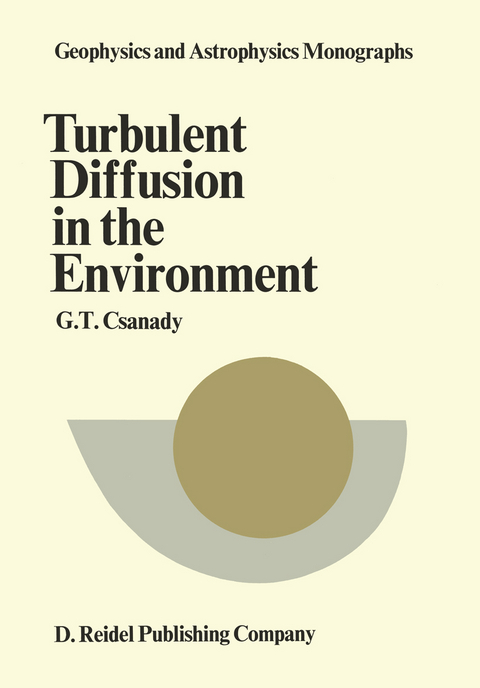
Turbulent Diffusion in the Environment
Kluwer Academic Publishers (Verlag)
978-90-277-0261-6 (ISBN)
I. Molecular Diffusion.- 1.1. Introduction.- 1.2. Concentration.- 1.3. Flux.- 1.4. Fick’s Law.- 1.5. Conservation of Mass.- 1.6. Instantaneous Plane Source.- 1.7. Some Simple Examples.- 1.8. Diffusion of Finite Size Cloud.- 1.9. ‘Reflection’ at Boundary.- 1.10. Two- and Three-Dimensional Problems.- 1.11. Continuous Sources.- 1.12. Source in Uniform Wind.- Appendix to Chapter I.- Exercises.- References.- II. Statistical Theory of Diffusion and Brownian Motion.- 2.1. Introduction.- 2.2. Dispersion Through Random Movements.- 2.3. Diffusion with Stationary Velocities.- 2.4. Brownian Motion.- 2.5. Dispersion of Brownian Particles.- 2.6. Simple Random Walk Model.- 2.7. Reflecting Barrier.- 2.8. Absorbing Barrier.- 2.9. Connection of Random Walk to Diffusion Equation.- 2.10. Deposition on Vertical Surfaces.- 2.11. Deposition on Horizontal Surfaces.- Exercises.- References.- III. Turbulent Diffusion: Elementary Statistical Theory and Atmospheric Applications.- 3.1. Fundamental Concepts of Turbulence.- 3.2. Field Measurements of Concentration and Dosage.- 3.3. The Statistical Approach to Environmental Diffusion.- 3.4. ‘Lagrangian’ Properties of Turbulence.- 3.5. Consequences of Taylor’s Theorem.- 3.6. The Form of the Particle-Displacement Probability Distribution.- 3.7. Mean Concentration Field of Continuous Sources.- 3.8. Apparent Eddy Diffusivity.- 3.9. Application to Laboratory Experiments.- 3.10. Application to Atmospheric Diffusion.- 3.11. Initial Phase of Continuous Plumes.- 3.12. Atmospheric Cloud Growth far from Concentrated Sources.- 3.13. The Non-Stationary Character of Atmospheric Turbulence.- 3.14. The Hay-Pasquill Method of Cloud-Spread Prediction.- Exercise.- References.- IV. ‘Relative’ Diffusion and Oceanic Applications.- 4.1. Experimental Basis.-4.2. Mean Concentration Field in a Frame of Reference Attached to the Center of Gravity.- 4.3. Probability Distributions of Particle Displacements.- 4.4. Kinematics of Particle Movements in a Moving Frame.- 4.5. Phases of Cloud Growth.- 4.6. History of a Concentrated Puff.- 4.7. Initially Finite Size Cloud.- 4.8. Use of the Diffusion Equation.- 4.9. Horizontal Diffusion in the Ocean and Large Lakes.- 4.10. Application to Diffusion of Sewage Plumes.- 4.11. Vertical Diffusion in Lakes and Oceans.- Exercise.- References.- V. Dispersion in Shear Flow.- 5.1. Introduction.- 5.2. Properties of the Planetary Boundary Layer.- 5.3. Particle Displacements in a Wall Layer.- 5.4. Continuous Ground-Level Line Source.- 5.5. Flux and Eddy Diffusivity.- 5.6. Comparison with Experiment.- 5.7. Continuous Point Source at Ground Level.- 5.8. Use of the Diffusion Equation.- 5.9. Elevated Sources.- 5.10. Longitudinal Dispersion in Shear Flow.- 5.11. Shear-Augmented Diffusion in a Channel.- 5.12. Dispersion in Natural Streams.- 5.13. Shear-Augmented Dispersion in Unlimited Parallel Flow.- 5.14. Diffusion in Skewed Shear Flow.- References.- VI. Effects of Density Differences on Environmental Diffusion.- 6.1. Introduction.- 6.2. Fundamental Equations.- 6.3. Approximate Forms of the Equations.- 6.4. Equations for Turbulent Flow.- 6.5. Turbulent Energy Equation.- 6.6. Diffusion Floors and Ceilings.- 6.7. Diffusion in a Continuously Stratified Fluid.- 6.8. Velocity Autocorrelation and Particle Spread in Stratified Fluid Model.- 6.9. Bodily Motion of Buoyant and Heavy Plumes.- 6.10. Dynamics of a Line Thermal.- 6.11. Similarity Theory.- 6.12. Bent-Over Chimney Plumes.- 6.13. Theory of Buoyancy Dominated Plumes in a Neutral Atmosphere.- 6.14. Comparison with Observation.- 6.15. Flow Pattern within aPlume.- 6.16. Effect of Atmospheric Stratification.- 6.17. Approximate Arguments for Plumes in Stratified Surroundings.- 6.18. Engineering Assessment of Ground Level Pollution from Buoyancy Dominated Plumes.- 6.19. Effects of Plume Rise on Ground-Level Concentration.- Appendix to Chapter VI.- A6.1. Momentum Plumes.- Exercise.- References.- VII. The Fluctuation Problem in Turbulent Diffusion.- 7.1. Introduction.- 7.2. Probability Distribution of Concentration.- 7.3. The Functional Form of the Probability Distribution.- 7.4. Hazard Assessment on the Basis of Concentration Probabilities.- 7.5. The Variance of Concentration Fluctuations.- 7.6. Self-Similar Fluctuation Intensity Distribution.- 7.7. Fluctuating Plume Model.- References.
| Erscheint lt. Verlag | 28.2.1973 |
|---|---|
| Reihe/Serie | Geophysics and Astrophysics Monographs ; 3 |
| Zusatzinfo | XII, 249 p. |
| Verlagsort | Dordrecht |
| Sprache | englisch |
| Maße | 170 x 244 mm |
| Themenwelt | Naturwissenschaften ► Geowissenschaften ► Geologie |
| Naturwissenschaften ► Geowissenschaften ► Hydrologie / Ozeanografie | |
| Naturwissenschaften ► Geowissenschaften ► Meteorologie / Klimatologie | |
| ISBN-10 | 90-277-0261-6 / 9027702616 |
| ISBN-13 | 978-90-277-0261-6 / 9789027702616 |
| Zustand | Neuware |
| Haben Sie eine Frage zum Produkt? |
aus dem Bereich


